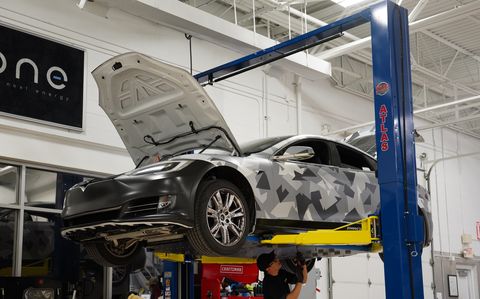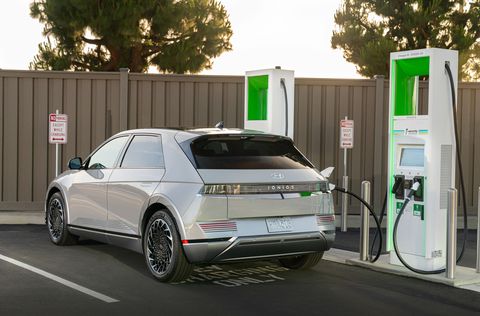Electric Car Battery Life: Everything You Need to Know

The simplicity of a battery electric vehicle is analogous to that of a digital watch. It’s uncomplicated, reliable, and cheap. By that token, a car with an internal combustion engine is a bit like a mechanical timepiece: full of complicated parts that require regular maintenance.
How Much Does an EV Battery Replacement Cost?
Of course, you can buy a pack of batteries for your digital watch for less than $10, while replacing the 40-kWh pack in a Nissan Leaf will run you thousands of dollars. Sure, electric cars have fewer moving parts to service and are generally cheaper to maintain, but the cost of replacing the battery pack remains the Achilles’ heel of EVs.
The Manufacturer
Even this is set to become less of an issue in the future, as manufacturing improvements and additional scale ought to make replacing an EV’s battery pack a less costly affair. Plus, we now have a better picture of the typical EV battery pack’s average service life thanks to the global uptick in sales of such vehicles.
Battery Basics
Most modern electric cars use a lithium-ion battery pack to store energy. While other battery types are expected to power the motors of electric cars in the coming years, such as solid-state batteries, the current infrastructure for large-scale battery production favors those of the lithium-ion type.
Lithium-ion batteries have the following benefits:
Lithium-ion batteries have a higher energy density than conventional lead-acid batteries, such as those that power the electrics of most modern cars, or nickel-metal hydride batteries, which are currently used in many hybrid cars, such as those from Toyota.Lithium-ion batteries self-discharge at a lower rate than other battery types.Lithium-ion batteries do not require periodic full discharges, nor any maintenance to electrolytes.Lithium-ion batteries provide more consistent voltage even as the charge degrades.
In the simplest terms, an electric car with a lithium-ion battery pack performs similarly to a car with an internal combustion engine and a full tank of gasoline, as an EV with the right combination of battery capacity, curb weight, and aerodynamic efficiency can drive hundreds of miles between charges. However, a EV’s peak power does tend to diminish with its state of charge, which is why we do all of our performance testing starting with a 100-percent charge.

Our Next Energy (ONE)
That said, lithium-ion batteries do have some drawbacks:
Lithium-ion batteries are expensive to produce, and mining the cobalt and nickel required to make these energy storage devices is rife with both environmental and humanitarian concerns.Onboard battery management is critical to the longevity of lithium-ion batteries.Fully charging and fully discharging lithium-ion batteries takes a toll on their service life.Though the chances are low, lithium-ion batteries have the potential to overheat and catch fire.Extreme temperatures affect the charging and discharging of lithium-ion batteries.
Automakers, however, have addressed most of these issues by developing software that manages the battery’s health and temperature, the latter of which also includes dedicated hardware, such as cooling and heating systems designed to improve the efficiency (and safety) of lithium-ion battery packs whether they’re motivating an EV through Norway during the peak of winter or Texas in the midst of an extreme heat wave.

Polestar
Battery Life Expectancy
Guesswork aside, the simplest way to judge the longevity of a battery pack is by way of the manufacturer’s warranty. Given the cost of replacing a battery pack, no automaker wants to get stuck with this bill due to the fact they overestimated the pack’s resiliency and longevity. The battery’s limited warranty, thus, provides an insight into what the manufacturer views as the typical pack’s minimum life expectancy.
All EVs sold today include a battery warranty of at least eight years and 100,000 miles. Tesla, for instance, offers an eight-year battery warranty and coverage of between 100,000–150,000 miles depending on the specific model.
This warranty doesn’t only cover the complete failure of the battery pack, it also serves as a guarantee against serious degradation. With each charge cycle, lithium-ion battery packs lose a fraction of their total capacity. As time goes on, these small hits to the pack’s maximum capacity take a toll on the overall driving range of an EV.

Tesla’s fine print says, for example, that a vehicle such as the Model 3 should maintain at least 70 percent of its charge capacity while its pack is still under warranty. If charge capacity falls below that during the warranty window, then owners should expect Tesla to address and cover the costs of this battery-related issue.
Tesla’s not working with an arbitrary percentage, either, as the likelihood of one of its vehicles’ battery packs degrading to less than 70 percent of its original charge capacity during the warranty period is slim. A crowd-sourced study by Tesla owners in the Netherlands—using data from Teslas sold throughout the world—showed that the battery packs of Model S sedans were seeing an average rate of degradation of around 5 percent during the first 50,000 miles of driving. This curve becomes less steep as more miles are added, too, with the study indicating the battery packs of these long-range Teslas typically held at least 90 percent of their original charge after 150,000 miles of driving. Our long-term Model 3 lost roughly 6 percent of its battery capacity after the first 20,000 miles but then didn’t degrade any further all the way to 40,000 miles over 2 years.
Hyundai offers a similar battery warranty for its EV of the Year-winning Ioniq 5, with coverage of 10 years or 100,000 miles. It also covers battery degradation, with Hyundai expecting the Ioniq 5’s pack to lose no more than 30 percent of its original charge during the warranty period.

Hyundai
The U.S. Department of Energy, meanwhile, predicts today’s EV batteries ought to last a good deal past their warranty period, with these packs’ service lives clocking in at between 12 and 15 years if used in moderate climates. Plan on a service life of between 8 and 12 years if your EV is regularly used in more extreme conditions.
Safety and Maintenance of an Electric Car
Except for the likes of low-speed neighborhood electric vehicles, electric cars sold in the United States are held to the same safety standards as all other passenger vehicles. Additionally, EV battery packs are required to be encased in a sealed shell, as well as be able to handle testing conditions related to overcharging, extreme temperatures, fires, accidents, water immersion, vibrations, and short-circuiting, per DOE. EVs also need to use “insulated high-voltage lines” and be able to deactivate their electrical systems in the event of a crash or short circuit.

picture alliance|Getty Images
Battery-related electric car fires often grab headlines because they are harder to fight. Yet, the likelihood of an electric car catching fire is far less likely than that of a vehicle with an internal combustion engine. In short, the chances of an electric car catching fire are extremely slim; however, should such a fire occur, it’ll likely require the local fire department to put it out.
Maintaining an electric car is a relatively straightforward affair. Owners need to keep an eye on fluids (coolant, refrigerant, windshield wash), tires, and brake pads and rotors, though the latter items ought to last longer than those of cars with internal combustion engines as the regenerative braking function of EVs puts less wear on the mechanical braking bits.
Battery Charging Cycles
Though it’s certainly not unheard of, most drivers do not drive their car until it’s completely out of fuel. The same applies to EVs. Owners may drive their vehicle to a very low state of charge, but most will likely avoid completely draining the battery pack. Given the ease of plugging in at home, it’s possible that even fewer EV drivers will ever completely discharge their vehicle’s battery pack.

EVgo
How Charging Affects EV Battery Lifespan
Still, at-home charging isn’t the quickest way to increase an EV’s state of charge (though the nature of EV charging cycles, which often occur during long periods, such as overnight, means the slower speed of at-home charging rarely presents itself as a problem). For times when a quick charge is needed, fast chargers are the go-to option.
Nonetheless, these pricey but convenient chargers tend to degrade lithium-ion batteries at a quicker rate than lesser charging options. If you’re hoping to get the most service life from your EVs battery pack, then avoid unnecessary fast charging. That said, the battery in your EV is more than capable of handling fast charges in times of need without you having to worry about its effects on the pack’s internal bits.
Likewise, it’s best to avoid charging an EV’s battery to full capacity or letting it discharge entirely. Many electric cars include settings to adjust the maximum charge level, with many automakers recommending drivers charge the pack to 85- or 90-percent capacity for typical daily use.

shaunl|Getty Images
Battery Thermal Management Systems
An active thermal management system is key to keeping an electric car’s lithium-ion battery pack at peak performance. Lithium-ion batteries have an optimum operating range of between 50–86 degrees Fahrenheit, a temperature range that most modern EVs attempt to maintain their battery packs at by way of a cooling/heating circuit.
Much like heating and cooling the interior of a car, heating and cooling an EV’s battery pack burns energy. As such, expect the overall driving range to suffer somewhat when driving in extreme temperatures. At least with these systems in place, EV battery packs are less likely to degrade at a notably greater rate than they would in less extreme temperatures.
The truth is that today’s EV batteries will inevitably need replacing in the future. Fortunately, modern EV battery packs should prove problem-free for nearly the first decade of use—possibly even longer. By the time today’s EVs will need a replacement battery pack it’s likely the manufacturing and material costs will be far less than they are today. We’re not saying that replacing your EV’s lithium-ion battery pack a decade from now will be cheap, but we wager doing so will be much more affordable than it is today.



